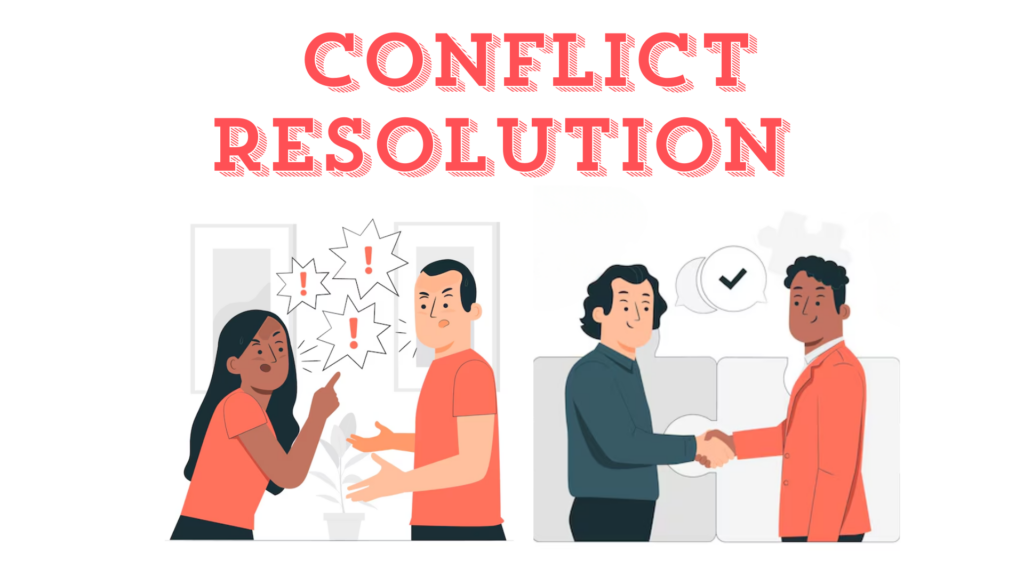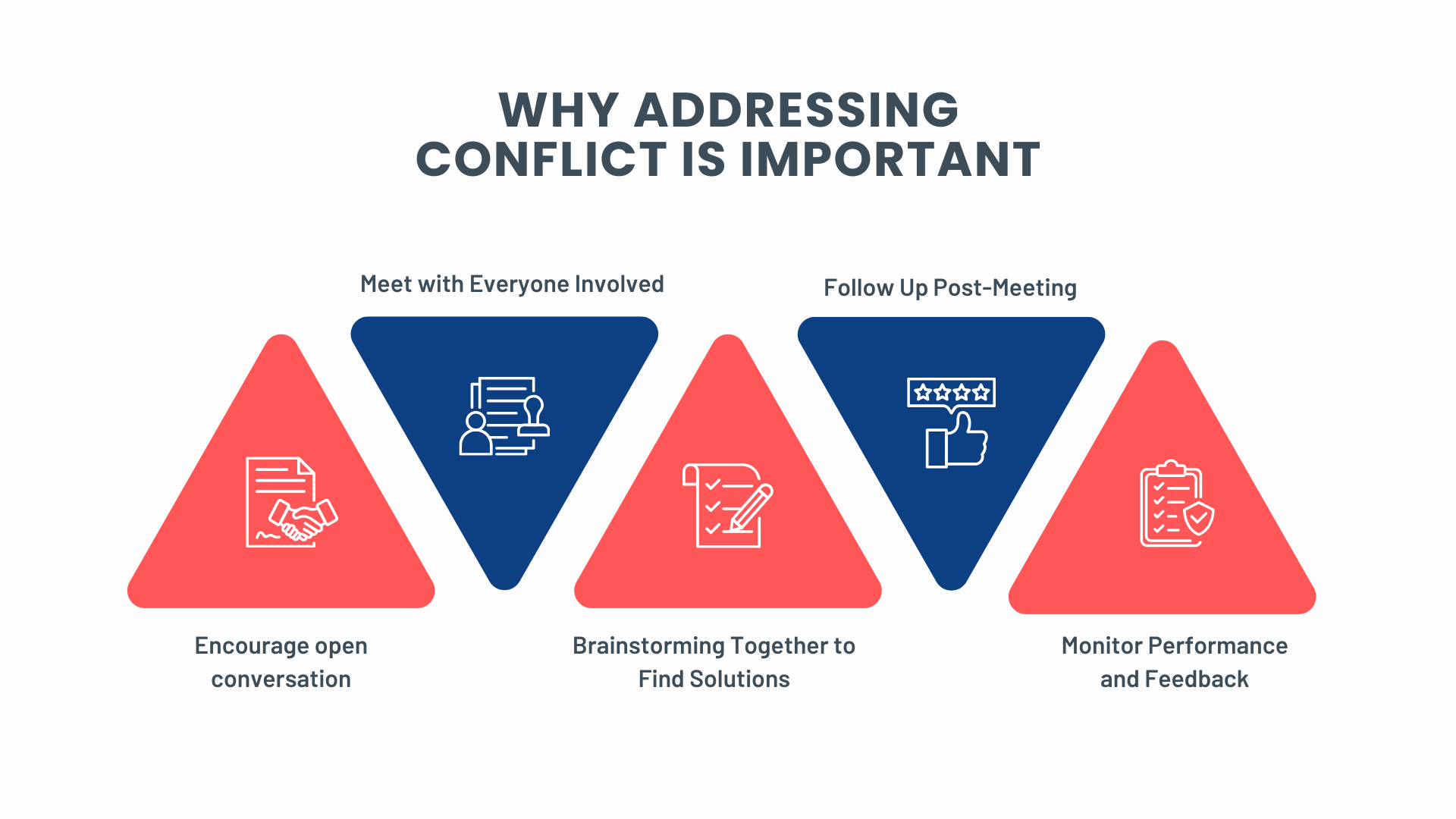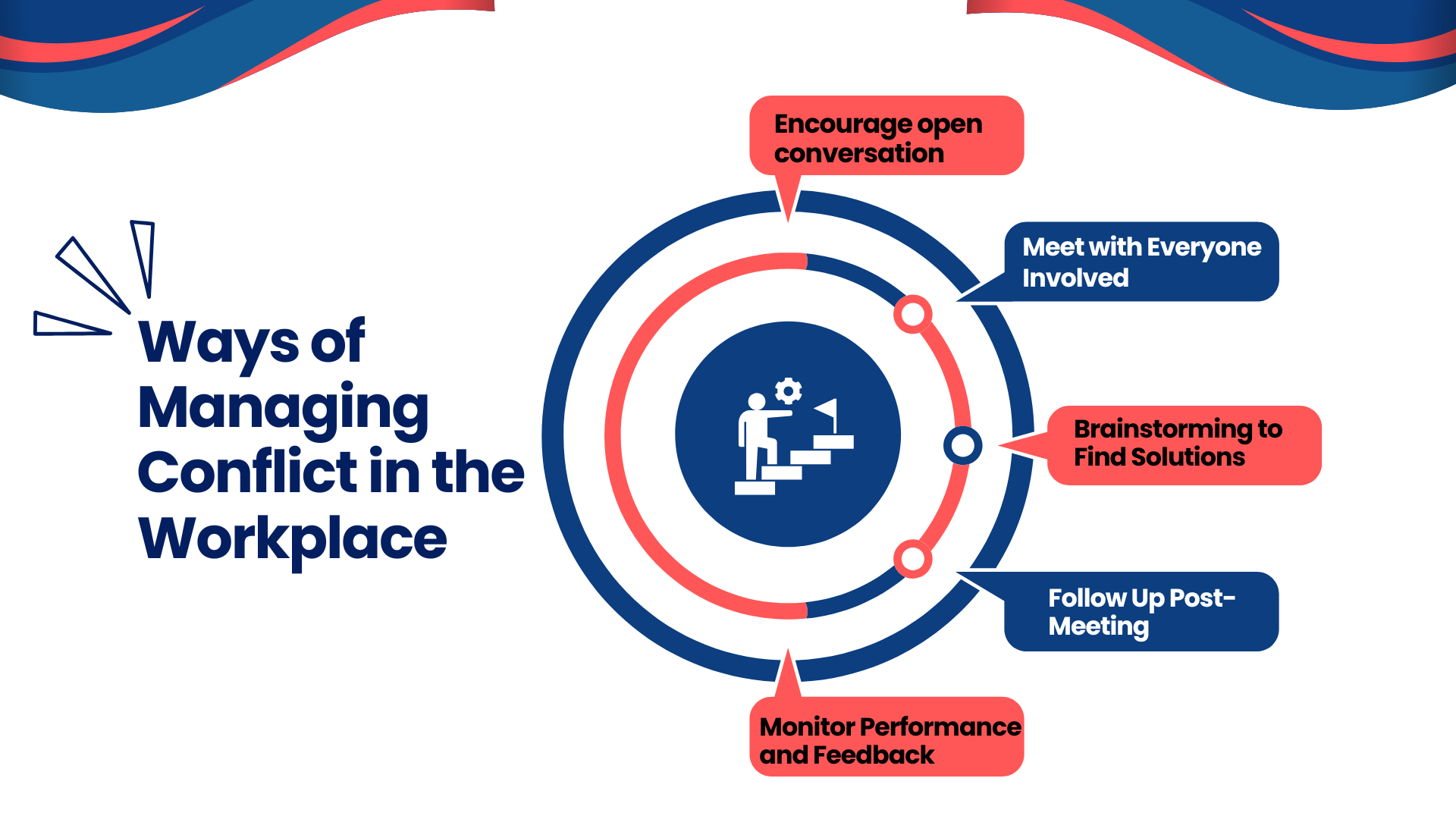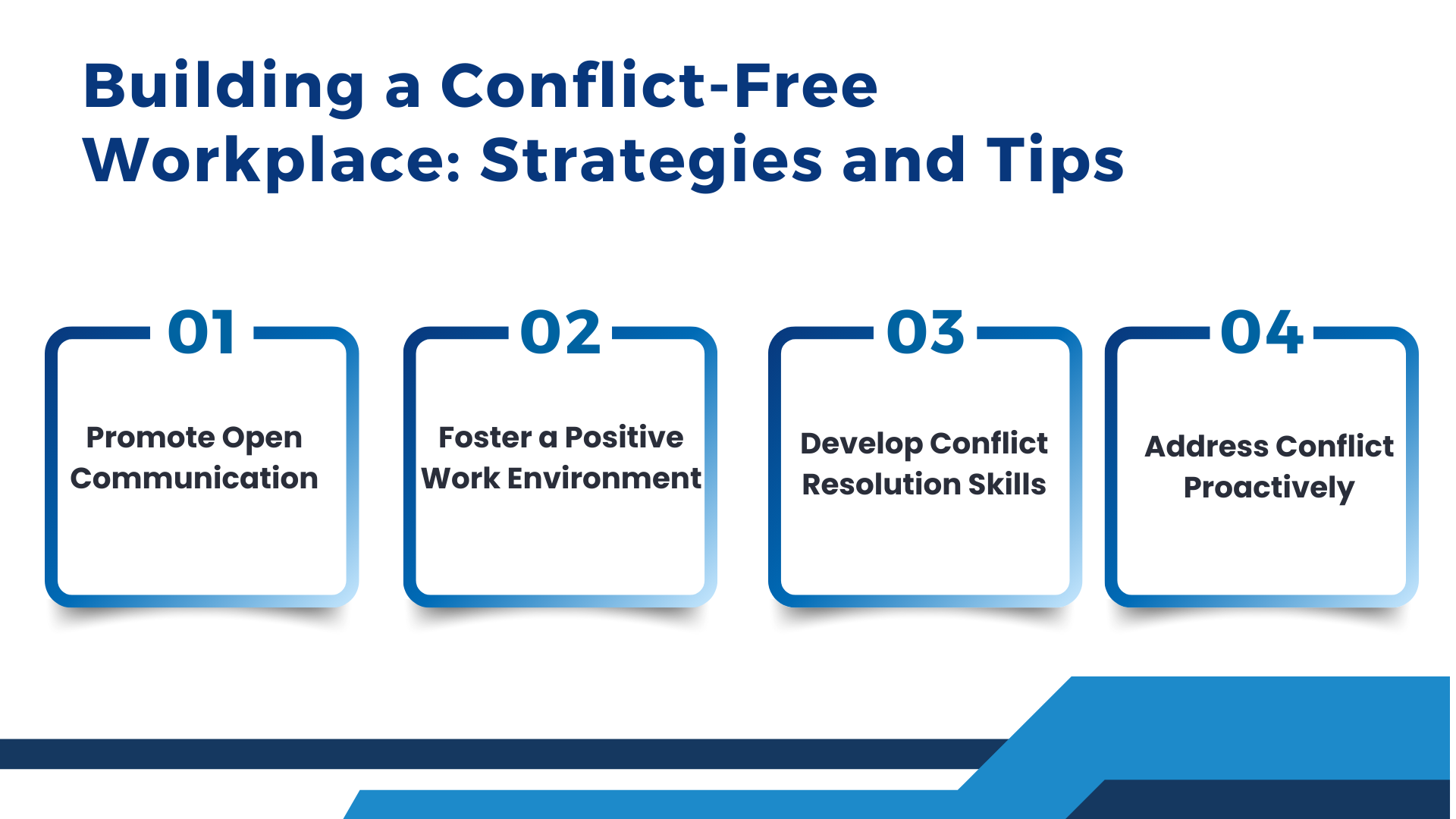
Workplace conflicts are inevitable but can significantly impact team productivity if not managed effectively. Unresolved issues may lead to decreased work output, negative attitudes, and higher employee turnover. The Human Resource department is responsible for addressing conflicts promptly and implementing proactive measures to manage them early. By fostering open communication, mediating disputes, and establishing clear conflict resolution protocols, HR can create a positive, collaborative work environment that enhances productivity and employee retention.
This guide will explain the reciprocating symptoms: why can there be conflicts, the harm of ignoring those, how can they be solved, and what HR can do to make workplace relations healthier.
Reasons for Workplace Conflict
Conflicts at work can emerge from a conflict in any of the tasks being worked on or from conflicting interests. Such occurrences can be common sources of complaints, such as the following:
- Failure to Communicate
Lack of communication or communication deficit has been known to cause conflicts in the workplace. As a result of this, friction and conflict are bound to take place.
- Different Approaches to Work
Everyone has his or her own way of doing things and this difference can sometimes cause problems. Some people tend to be delegate more than the others, which may cause friction in the teamwork.
- Disputes Over Authority
Domain conflicts can also arise in a similar manner where disagreements concerning power and responsibility come into play, especially when one employee believes that someone else is acting beyond their authority.
- Resource Scarcity
Limited resources, whether financial, material, or human, can create competition among employees, leading to conflict.
- Cultural Differences
A diverse workplace is an asset, but differences in cultural norms, values, or practices can sometimes lead to misunderstandings and conflict.
Why It Is Necessary to Deal With Conflict
Addressing workplace conflict promptly and effectively is crucial for several reasons:
There are many different reasons why it is important to address issues related to conflict in the workplace in a timely manner, and also in an effective manner.
- Maintaining Output
Most forms of conflict cause interruptions, a lack of concentration, and problems with collaboration. Such disagreements, if not settled, may eventually lead to a reduction in general output.
- Safeguarding Employees’ Morale
If the controls do not work, most likely, the morale will be impacted and some employees will feel supported, and some will believe that their issues are ignored. This will most probably cause rising absenteeism and disengagement.
- Reducing Workforce Costs
Some employees tend to show their discontent with the management morals by resigning which can prove to be an expensive affair and even loss of skilled people in the organization.
- Encouraging Healthy Work Ethics
When there is a culture in the organization that allows and encourages solving problems before they get out of hand, employees feel appreciated and work better. This is beneficial in making teamwork easy and constructive.
Ways of Conflict Resolution in the Workplace
In every organization, when conflict arises between members, the resolution process should be strategic. These are some of the strategic approaches that HR practitioners can undertake:
1. Encourage open conversation: Create a safe and supportive environment where employees feel comfortable expressing their concerns and perspectives without fear of judgment or reprisal.
- Sit with the parties in question and listen to each version of what is happening
- Sympathize with each individual and ask them what they feel should be done
- Seek to understand why they feel that way and offer resolutions
-
Meet with Everyone Involved: Set up meetings with all individuals affected by the conflict. This can involve one-on-one conversations or a group discussion to ensure each party’s point of view is heard. Ensuring transparency and inclusion helps foster trust and clarity.
- Allow both sides to be heard and remain transparent in your decisions
- Work to find solutions that make both parties happy
- Show them you care about their situation while reminding them you’re all there to do a job for the good of the business
-
Brainstorming Together to Find Solutions: After understanding the root cause of the conflict, bring everyone together to brainstorm potential solutions. Collaborative problem-solving empowers employees to contribute to the resolution, making them feel more invested in the outcome.
- Encourage employees to find creative solutions to their concerns
- Adopt a coaching mindset and not a problem-solver mode
- Help employees understand the impact of their actions on others
-
Follow Up Post-Meeting: Conflict resolution doesn’t end with one meeting. After decisions or solutions are made, it’s essential to follow up with all parties to ensure the issue is being managed effectively. Check if the agreed-upon steps are being implemented and whether further action is needed.
- Send a concise email summarizing key takeaways, decisions, and action items from the meeting.
- Clearly outline deadlines for action items and responsibilities to maintain accountability.
- Invite participants to share additional thoughts or questions after the meeting to foster transparency and collaboration.
-
Monitor Performance and Feedback: Continuously monitor the performance of individuals after the conflict resolution process. Regular feedback sessions help to identify whether the conflict has been fully resolved or if there are lingering issues that need to be addressed.
- Define specific performance metrics to evaluate progress and success.
- Schedule regular check-ins to discuss performance, address challenges, and provide support.
- Create opportunities for team members to provide feedback on processes and performance to encourage continuous improvement.
The Role of HR in Conflict Resolution
Human Resources (HR) plays a crucial role in preventing and resolving conflicts within organizations. HR professionals act as mediators, facilitators, and educators, ensuring a harmonious and productive work environment.
Here are some of the key roles HR plays in conflict resolution:
1. Prevention:
- Policy Development: HR helps create clear policies and procedures to address workplace conflicts proactively.
- Training: HR provides training on conflict resolution skills, helping employees understand and manage conflicts effectively.
- Culture Building: HR fosters a positive work culture that promotes respect, communication, and collaboration.
2. Mediation:
- Facilitation: HR can facilitate open communication between conflicting parties, helping them understand each other’s perspectives.
- Neutral Party: HR acts as a neutral mediator, ensuring fairness and impartiality in the conflict resolution process.
- Problem-Solving: HR helps parties identify the root causes of the conflict and develop mutually beneficial solutions.
3. Investigation:
- Fact-Finding: HR conducts thorough investigations into complaints of harassment, discrimination, or other workplace misconduct.
- Fairness: HR ensures that investigations are conducted fairly and impartially, protecting the rights of all parties involved.
- Disciplinary Action: HR may recommend disciplinary action if necessary, based on the findings of the investigation.
4. Employee Assistance:
- Counseling: HR can provide employees with access to counseling services to help them cope with stress, anxiety, or personal issues that may contribute to conflict.
- Support: HR offers support to employees who are involved in conflicts, helping them navigate the process and find resolution.
5. Post-Resolution Follow-Up:
- Monitoring: HR monitors the situation after a conflict has been resolved to ensure that the agreed-upon solutions are being implemented.
- Feedback: HR gathers feedback from employees to identify areas for improvement in the conflict resolution process.
By actively participating in conflict resolution, HR professionals can help organizations maintain a positive and productive work environment, fostering employee satisfaction and organizational success.
Building a Conflict-Free Workplace: Strategies and Tips
A conflict-free workplace is a desirable goal for any organization, as it can lead to increased productivity, improved morale, and a more positive work environment. Here are some strategies to help you build a conflict-free workplace:
Promote Open Communication:
- Encourage open dialogue: Create a culture where employees feel comfortable expressing their thoughts, opinions, and concerns without fear of judgment or reprisal.
- Active listening: Teach employees the importance of active listening, which involves paying full attention to the speaker, understanding their perspective, and responding thoughtfully.
- Regular feedback: Establish regular feedback mechanisms, such as one-on-one meetings or performance reviews, to provide employees with constructive feedback and address any concerns they may have.
Foster a Positive Work Environment:
- Respectful behavior: Set clear expectations for respectful behavior among all employees, including avoiding personal attacks, gossip, and discrimination.
- Fair treatment: Ensure that all employees are treated fairly and equitably, regardless of their position, background, or personal characteristics.
- Work-life balance: Promote a healthy work-life balance to reduce stress and prevent burnout, which can contribute to conflict.
Develop Conflict Resolution Skills:
- Training and education: Provide training and education on conflict resolution skills, such as negotiation, mediation, and problem-solving.
- Encourage collaboration: Foster a collaborative culture where employees work together to find solutions to problems, rather than competing against each other.
- Mediation services: Consider offering mediation services as a way to resolve conflicts peacefully and efficiently.
Address Conflict Proactively:
- Early intervention: Address conflicts as soon as they arise to prevent them from escalating.
- Neutral third party: Involve a neutral third party, such as a supervisor or HR representative, to facilitate a resolution.
- Formal grievance procedures: Establish clear and fair grievance procedures to allow employees to report and address conflicts.
Build Trust and Respect:
- Transparency: Be transparent and honest in your communications with employees.
- Recognition and appreciation: Recognize and appreciate employees’ contributions to the organization.
- Trust-building activities: Engage in trust-building activities, such as team-building exercises or shared goals.
By implementing these strategies, you can create a workplace where employees feel valued, respected, and empowered to work together effectively.
Steps to Effective Conflict Resolution
To resolve conflicts effectively, HR should follow a structured process. Here are the steps to consider:
- Identify the Conflict
The first step is to recognize that a conflict exists. This may come through formal complaints, observation, or informal conversations. - Understand the Root Cause
It’s important to understand not just the symptoms of the conflict but the underlying causes. This can involve speaking with both parties and reviewing any relevant documentation. - Facilitate a Meeting
Bring the parties together in a neutral setting to discuss their grievances. HR should mediate the discussion to ensure it remains productive and focused on solutions. - Develop a Resolution Plan
Based on the discussion, create a plan that outlines the steps both parties will take to resolve the conflict. This plan should be documented and agreed upon by both parties. - Follow-Up
After the conflict is resolved, HR should follow up with both parties to ensure the resolution is working and to provide any additional support if necessary.
Conclusion:
Workplace conflict is a challenge every organization faces, but with the right strategies and the active involvement of HR, these disputes can be resolved in a way that strengthens team dynamics rather than weakening them. By promoting open communication, offering training, and providing a structured approach to conflict resolution, HR professionals can create a more harmonious and productive work environment.
Kredily, as an all-in-one HRMS platform, offers tools that facilitate efficient communication, provide resources for conflict resolution, and ensure HR managers can stay on top of employee issues before they escalate. With its easy-to-use interface and comprehensive features, Kredily makes managing workplace conflicts simpler and more effective.
Key Takeaways from Kredily’s Conflict Resolution Approach:
- Automated Communication Tools: Facilitates open dialogue among team members and between HR and employees.
- Customizable HR Policies: Ensure conflict resolution processes are clear and accessible to all employees.
- Employee Engagement Analytics: Identify conflict trends and take preventive measures before issues arise.
- Seamless Documentation: Track conflicts, resolutions, and follow-up actions with ease.
Ready to streamline your HR processes and create a more harmonious workplace? Explore Kredily’s HRMS platform today!




